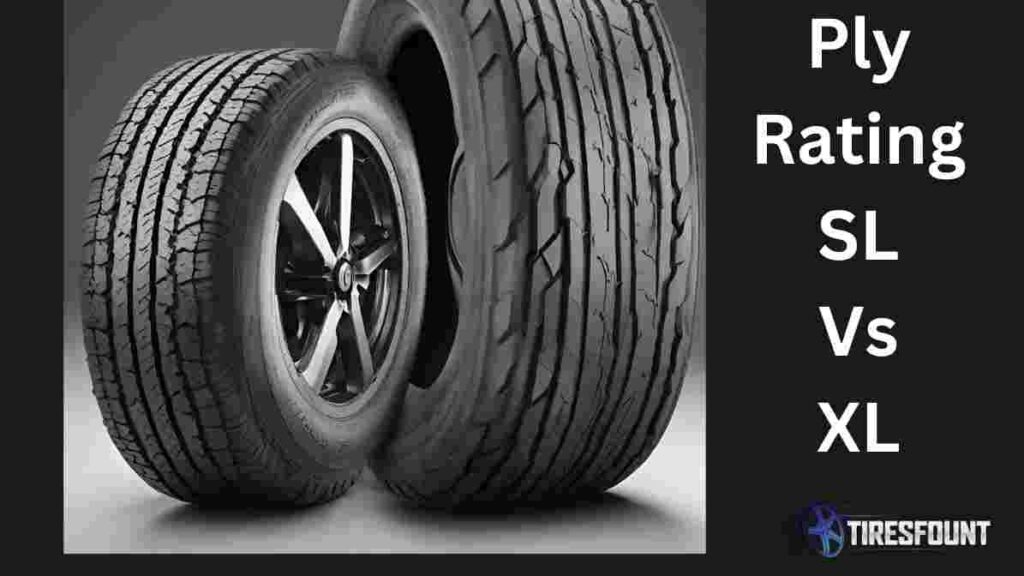This difference is crucial in determining the right tire for your vehicle and its usage.
More specifically, SL (Standard Load) tires are suitable for most passenger vehicles, while XL (Extra Load) tires are designed for vehicles that carry heavier loads or operate at higher speeds.
The distinction between these two ratings has significant implications for tire performance, durability, and safety.
In the subsequent parts of this article, we will explore these differences in detail, discussing their impact on various aspects of driving and vehicle performance.
Keep reading to find out what ply rating is best for your vehicle.

SL Ply Rating vs XL Rating: An Overview
Before going to a detailed discussion, let’s have a look at the overview. This info is mainly in general. Based on different brands, they may be slightly different.
| Feature | SL Ply Rating | XL Ply Rating |
| Ply Rating | 4-ply or less Ply Rating(4 Ply Vs 6 Ply Tires) | 4-ply or higher Ply Rating |
| Load Capacity | Standard load capacity | Higher load capacity |
| Inflation Pressure | Normal inflation pressure | Higher inflation pressure recommended |
| Application | Standard passenger vehicles | Performance and high-load vehicles |
| Construction | Conventional construction | Reinforced construction to handle heavier loads |
| Ride Comfort | Generally offers a smoother ride | May result in a slightly stiffer ride |
| Common Symbols | “SL” marked on the sidewall | “XL” or “RF” (Reinforced) marked on the sidewall |
Detailed Differences Between Ply Rating SL vs XL
After the table, the detailed discussion will help you more to know why SL and Xl are different from each other.
Definition
Standard Load (SL) tires means that the tires have a standard ply rating and can carry a standard amount of load.
On the other hand, Extra Load (XL) tires, also known as reinforced tires, means that these tires have a higher ply rating and can carry extra load.
Load Index
The load index of SL tires is usually lower because they are designed to carry a standard load.
Instead, the load index of XL tires is higher as they are specifically designed to carry extra load compared to their SL counterparts.
Air Pressure Requirement
Air pressure is also an important point of their differences. SL tires need regular air pressure as they are not designed to carry heavy loads.
XL tires require more air pressure in order to provide support for the extra load they are designed to carry.
Vehicle Type
SL tires are usually recommended for lighter passenger vehicles or compact cars.
XL tires are often recommended for larger vehicles such as SUVs, mini-vans, and light trucks.
Cost Differences
Generally, SL tires are less expensive because they aren’t designed to carry heavy loads.
XL tires usually cost more due to their enhanced carrying capacity. The cost may vary based on the manufacturer.
Can You Use SL And XL Tire Interchangeably?
It’s not advisable to use Standard Load (SL) and Extra Load (XL) tires interchangeably without considering the specific requirements of your vehicle.
If you use SL tire in your small truck then it will not be able to carry the load. But it is more realistic if you use XL instead of SL because XL is stronger than SL.
If you still want to use them interchangeably, you have to consider some points that are given below.
- Load Capacity: XL tires are designed to carry heavier loads than SL tires. If your vehicle requires XL tires, using SL tires may result in inadequate load-bearing capacity, which can compromise safety and performance.
- Inflation Pressure: XL tires often require higher inflation pressures to support their increased load capacity. Using SL tires instead of XL tires may lead to underinflation, affecting the tire’s performance and safety.
- Ride Comfort and Handling: XL tires may have a stiffer construction to handle higher loads, which could impact ride comfort. Using SL tires on a vehicle that requires XL tires may result in a smoother but potentially compromised ride.
- Performance Characteristics: XL tires are commonly used on performance and high-load vehicles. Using SL tires on such vehicles may affect handling, braking, and overall performance.
While there might be some situations where using SL tires instead of XL tires is permissible, it’s crucial to consult with a tire professional or follow the recommendations provided by your vehicle manufacturer.
Conclusion
From here, we’ve learned that Xl or SL aren’t just random letters stamped on your tires. They have important meanings and implications for your vehicle’s performance, safety, and even fuel efficiency.
By understanding what they mean, you can ensure a safer, smoother, and more efficient ride.
Drive safe!
Check our Play Rating Comparision
